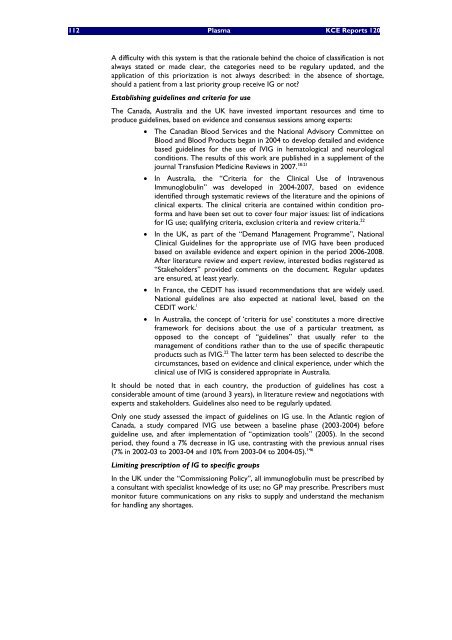The report is available in English with a French summary - KCE
The report is available in English with a French summary - KCE
The report is available in English with a French summary - KCE
Create successful ePaper yourself
Turn your PDF publications into a flip-book with our unique Google optimized e-Paper software.
112 Plasma <strong>KCE</strong> Reports 120<br />
A difficulty <strong>with</strong> th<strong>is</strong> system <strong>is</strong> that the rationale beh<strong>in</strong>d the choice of classification <strong>is</strong> not<br />
always stated or made clear, the categories need to be regulary updated, and the<br />
application of th<strong>is</strong> priorization <strong>is</strong> not always described: <strong>in</strong> the absence of shortage,<br />
should a patient from a last priority group receive IG or not?<br />
Establ<strong>is</strong>h<strong>in</strong>g guidel<strong>in</strong>es and criteria for use<br />
<strong>The</strong> Canada, Australia and the UK have <strong>in</strong>vested important resources and time to<br />
produce guidel<strong>in</strong>es, based on evidence and consensus sessions among experts:<br />
• <strong>The</strong> Canadian Blood Services and the National Adv<strong>is</strong>ory Committee on<br />
Blood and Blood Products began <strong>in</strong> 2004 to develop detailed and evidence<br />
based guidel<strong>in</strong>es for the use of IVIG <strong>in</strong> hematological and neurological<br />
conditions. <strong>The</strong> results of th<strong>is</strong> work are publ<strong>is</strong>hed <strong>in</strong> a supplement of the<br />
journal Transfusion Medic<strong>in</strong>e Reviews <strong>in</strong> 2007. 18-21<br />
• In Australia, the “Criteria for the Cl<strong>in</strong>ical Use of Intravenous<br />
Immunoglobul<strong>in</strong>” was developed <strong>in</strong> 2004-2007, based on evidence<br />
identified through systematic reviews of the literature and the op<strong>in</strong>ions of<br />
cl<strong>in</strong>ical experts. <strong>The</strong> cl<strong>in</strong>ical criteria are conta<strong>in</strong>ed <strong>with</strong><strong>in</strong> condition proforma<br />
and have been set out to cover four major <strong>is</strong>sues: l<strong>is</strong>t of <strong>in</strong>dications<br />
for IG use; qualify<strong>in</strong>g criteria, exclusion criteria and review criteria. 22<br />
• In the UK, as part of the “Demand Management Programme”, National<br />
Cl<strong>in</strong>ical Guidel<strong>in</strong>es for the appropriate use of IVIG have been produced<br />
based on <strong>available</strong> evidence and expert op<strong>in</strong>ion <strong>in</strong> the period 2006-2008.<br />
After literature review and expert review, <strong>in</strong>terested bodies reg<strong>is</strong>tered as<br />
“Stakeholders” provided comments on the document. Regular updates<br />
are ensured, at least yearly.<br />
• In France, the CEDIT has <strong>is</strong>sued recommendations that are widely used.<br />
National guidel<strong>in</strong>es are also expected at national level, based on the<br />
CEDIT work. l<br />
• In Australia, the concept of ‘criteria for use’ constitutes a more directive<br />
framework for dec<strong>is</strong>ions about the use of a particular treatment, as<br />
opposed to the concept of “guidel<strong>in</strong>es” that usually refer to the<br />
management of conditions rather than to the use of specific therapeutic<br />
products such as IVIG. 22 <strong>The</strong> latter term has been selected to describe the<br />
circumstances, based on evidence and cl<strong>in</strong>ical experience, under which the<br />
cl<strong>in</strong>ical use of IVIG <strong>is</strong> considered appropriate <strong>in</strong> Australia.<br />
It should be noted that <strong>in</strong> each country, the production of guidel<strong>in</strong>es has cost a<br />
considerable amount of time (around 3 years), <strong>in</strong> literature review and negotiations <strong>with</strong><br />
experts and stakeholders. Guidel<strong>in</strong>es also need to be regularly updated.<br />
Only one study assessed the impact of guidel<strong>in</strong>es on IG use. In the Atlantic region of<br />
Canada, a study compared IVIG use between a basel<strong>in</strong>e phase (2003-2004) before<br />
guidel<strong>in</strong>e use, and after implementation of “optimization tools” (2005). In the second<br />
period, they found a 7% decrease <strong>in</strong> IG use, contrast<strong>in</strong>g <strong>with</strong> the previous annual r<strong>is</strong>es<br />
(7% <strong>in</strong> 2002-03 to 2003-04 and 10% from 2003-04 to 2004-05). 146<br />
Limit<strong>in</strong>g prescription of IG to specific groups<br />
In the UK under the “Comm<strong>is</strong>sion<strong>in</strong>g Policy”, all immunoglobul<strong>in</strong> must be prescribed by<br />
a consultant <strong>with</strong> special<strong>is</strong>t knowledge of its use; no GP may prescribe. Prescribers must<br />
monitor future communications on any r<strong>is</strong>ks to supply and understand the mechan<strong>is</strong>m<br />
for handl<strong>in</strong>g any shortages.

















